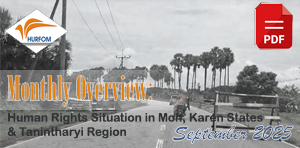Women narratives: the life of a refugee
June 11, 2012
WCRP: Her alias is Naw La Marn and she is 31 years old. She has two sons (nine and twelve) and a six-year-old daughter. She grew up in the village of Kyaut Pyat in Kawkareik Township, Karen State, where she worked on a farm in her youth. But when Naw La Marn was 14, her family left home and never returned. When she married at age 18, the wedding was held in a refugee camp. Read more
Women IDPs and refugees continue to face challenges to livelihood
June 6, 2012
HURFOM: Women’s livelihoods in resettlement areas remain insecure due to shortages of food and employment. Although female internally displaced people (IDPs) and refugees face demanding environments in their respective camps, most of them do not want to go back to Burma. They worry that they will not have a place to live and do not trust the government to assume responsibility to help them resettle. Read more
DPW Analyzes Human Impact of Dawei Deep-Sea Port Project
June 5, 2012
HURFOM: The human rights and environmental advocacy group Dawei Project Watch released their assessment “No Rights To Know” investigating the lead up to and implementation of the Dawei deep-sea port project in the end of May 2012. The revealing document demonstrates how local residents did not have prior knowledge that a special economic zone was to be constructed right on top of their villages, because project authorities developed the plan in secret. Villagers were not afforded the rights to be involved in decision-makingor notified of key information that directly impacts their lives. Many residents now wonder and worry how the project will affect their communities, specifically security for young women and threats to cultural identity, customs, language, food supply, and other local resources. Read more
Young women leading community development projects
June 1, 2012
HURFOM: For the first time, villages in Ye and Yebyu Townships are receiving community development projects led by women. Traditionally, most women in these Townships do not participate in leadership roles, and communities may doubt their ability to achieve development goals. However, these recent projects developed new infrastructure and became a source of pride for the young women, but most importantly, they changed the way villagers think about female roles in the community. Read more



















































